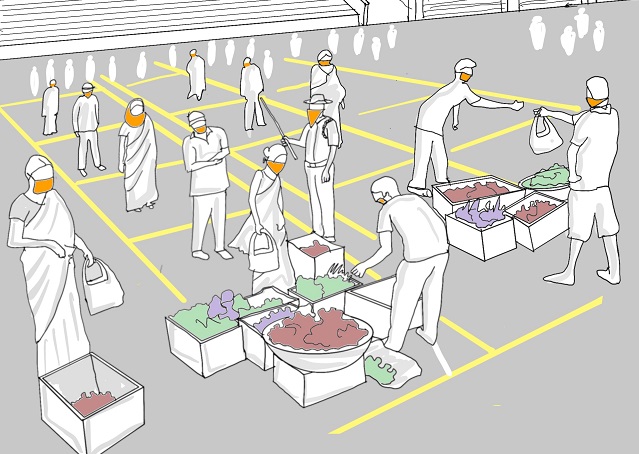
A temporary Rythu bazaar in Visakhapatnam, India. Illustration by Rajeev Malagi/WRI
When was the last time you walked through the market without being conscious about other people walking close to you or the last time you took a stroll to a neighborhood park without thinking about the hygiene around?
The COVID-19 pandemic has brought the world to a standstill. Though many places have come a long way from being locked inside our houses, we are still getting used to the new normal while working towards changing how we engage with spaces and people outdoors.
During the beginning of the pandemic in India, public spaces and streets were officially declared “risk zones,” as these spaces were social and economic engagement hubs. Eventually, streets and public spaces were reclaimed by people as emergency lifelines of the city. Streets helped channel movement of emergency vehicles and other essential services, and the maidans (city open grounds) and neighborhood open spaces served as hubs of pandemic operations like food distribution, medical centers, temporary markets and other needs.
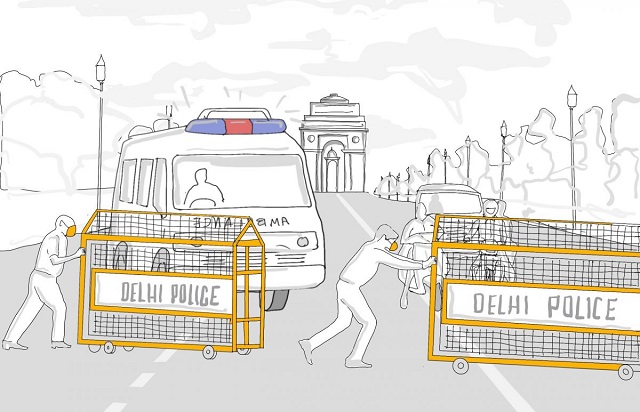
Arterial and other core streets functioned as spines for emergency vehicle movement during lockdowns. Illustration by Rajeev Malagi/WRI
As we come to terms with a slowly evolving new normal, it is imperative to rethink how our streets and open spaces, that underwent a conversion into emergency spaces, remain flexible while offering safe distancing to users. Tactical urbanism is one such jugaad (innovative process) to achieve this in a systematic and cost-effective way. Commonly known as “guerrilla” or “pop-up” urbanism, it includes low-cost, temporary changes to the built environment, enhancing neighborhoods and uplifting public spaces. These temporary changes can be tweaked through user feedback and even made permanent.
Here are some key considerations that make tactical urbanism a unique starting point for application of safe distancing measures:
1. A Cost-Effective and Quick Solution
Across the world, the pandemic has led to implementation of urgent measures in cities. Through tactical urbanism, low-cost, quick-fix solutions can be applied to resolve on-the-ground issues such as following safe distancing in public spaces, regulating traffic flow through junction improvements, and reclaiming spaces for community purposes. As a concept, it encourages community participation in implementation and creates opportunities for re-purposing existing infrastructure to create a new identity while ensuring user feedback. This generates low-cost interventions and reduces the risk of project failure, especially if the project is for the short term.
2. From Pop-Up to Permanent
The ongoing pandemic is putting pressure on authorities for immediate funding. Tactical urbanism acts as a bridge between conceptualizing and implementing projects. By testing solutions on the ground, they not only help cities validate large-scale investments for permanent implementation but also build awareness about the outcomes.
Cities like New York, Miami and Addis Ababa have experimented with urban space transformations through tactical urbanism that have become or are in the process of becoming permanent.
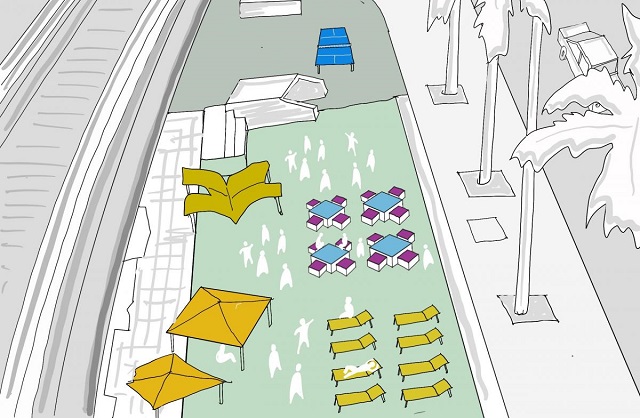
A demonstration of public space enhancement at Biscayne Green, a pop-up park in downtown Miami. Illustration by Rajeev Malagi/WRI
3. Small-Scale, But Scalable
The nature of tactical urbanism is adaptative and can help create immediate solutions that respond to the contextual needs of neighborhoods during emergency conditions. Once the needs are identified, solutions can be applied for the desired temporary functions and facilities, like emergency medical and food supply caps, temporary market spaces, etc. This process can then be applied to any other area or neighborhood in the city.
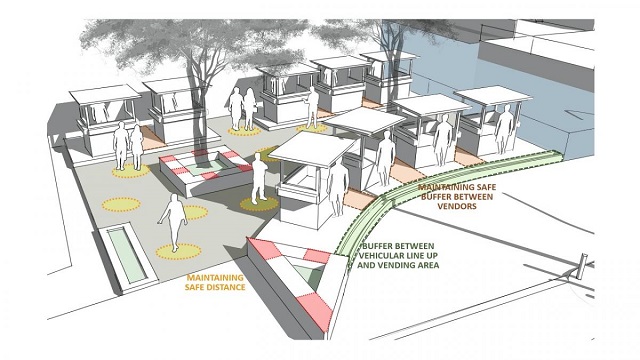
A demonstration of designing for safe distancing using simple surface markings and signage. Illustration by Shabna Seemanu/WRI
4. City-Community Collaborations
Tactical urbanism presents a unique opportunity to bring a coherence between public agencies and communities to arrive at more need-based solutions. Mandating stakeholder consultations to seek user inputs while assigning community marshals to monitor neighborhood needs and share them with the government can help build micro-ecosystems in cities. Bengaluru’s recent relief riders initiative, which supplied basic necessities to senior citizens during the lockdown, is an interesting case in point.
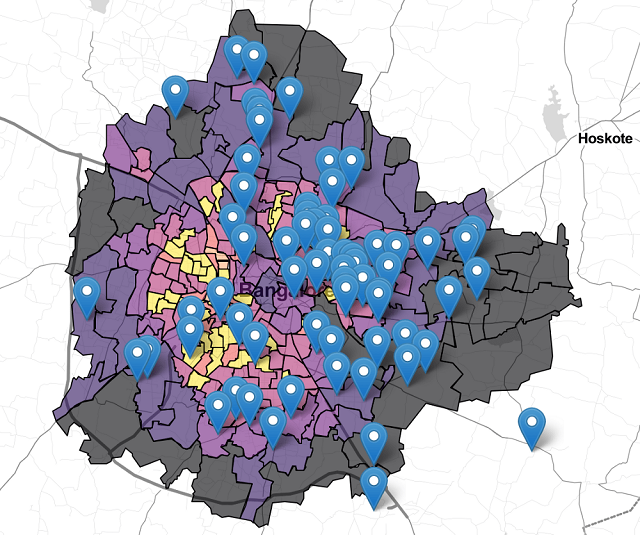
Bengaluru map with areas served by relief riders. Code and map by Chintan Sheth and Pavan Kumar Kaushik
5. Deciphering Priorities and Building Consensus
The temporary shutting down of mass transit systems and limited use of private vehicles during lockdowns had governments encouraging citizens to switch to walking and cycling as primary modes of travel. Cities like Bogotá and Paris created temporary cycle tracks as a means to facilitate safe distancing. Their increased usage and the changing behavioral patterns of residents has led some cities to make cycle tracks permanent. This demonstrates the strength of tactical urbanism in steering decision-making through a people-led approach and fostering tangible urban change. The flexibility to experiment before permanent implementation helps residents voice their acceptance, in turn informing public agencies about the needs and priorities of the city.
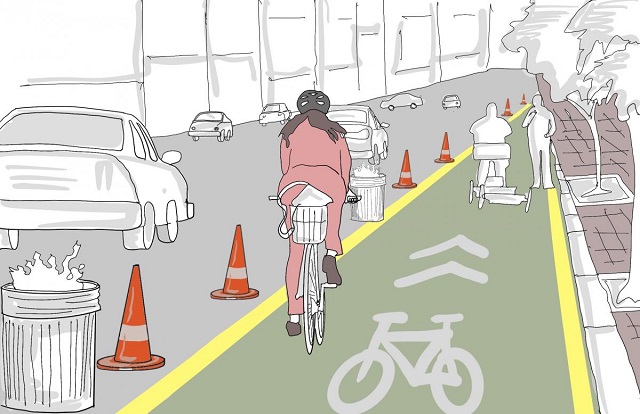
Existing bike lanes have been widened and new ones created to enable cyclists to keep further apart, across multiple American and European cities. Illustration by Rajeev Malagi/WRI
6. Awareness Tool
Addressing issues through tactical urbanism helps attain public awareness at two levels. First, physical planning through temporary, small-scale changes helps demonstrate the extent of physical segregation required in public spaces. Second, this kind of space reorganization nudges people to observe the imposed norm while building awareness not just due to user experience but also by word of mouth.
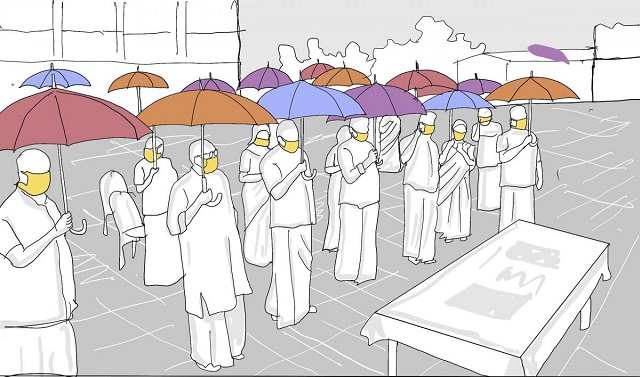
Initiatives like the “Break the Chain Umbrella” project demonstrate innovative ways of imparting knowledge about social distancing through simple props. Illustration by Rajeev Malagi/WRI India
These systematic, small-scale, creative efforts are useful not only for emergency situations but also in informing implementation agencies about future adoption of applied solutions. Moreover, testing such solutions using low-cost changes helps achieve positive project outcomes without incurring large losses to capital budgets. It is imperative to acknowledge the potential of tactical urbanism and evolve “hybrid models” for city improvements during this crisis as well as for long-term solutions, especially for restructuring budget allocations that can facilitate and scale up successful applications.
This blog was originally published on WRI India.
is a Senior Project Associate with the Urban Development and Accessibility team at WRI India Ross Center for Sustainable Cities.
is Lead for Urban Development at WRI India Ross Center for Sustainable Cities.





